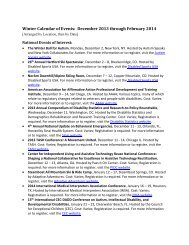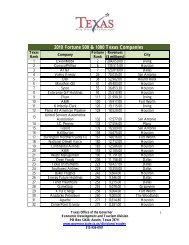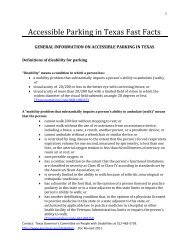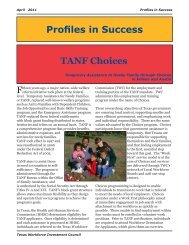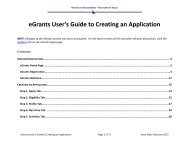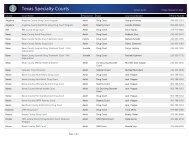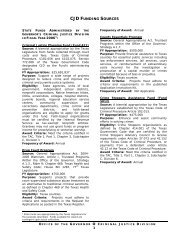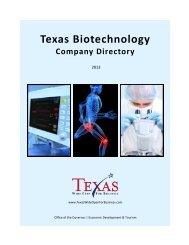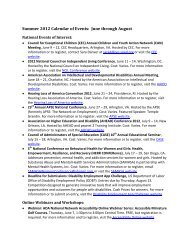People with Disabilities: A Texas Profile
People with Disabilities: A Texas Profile
People with Disabilities: A Texas Profile
Create successful ePaper yourself
Turn your PDF publications into a flip-book with our unique Google optimized e-Paper software.
Table 5: Number of Individuals in U.S. by Age Category and Disability Type, 2011<br />
Age Category and Disability<br />
Total Number of<br />
Individuals in U.S.<br />
by Age Category<br />
Total Number<br />
of Individuals<br />
<strong>with</strong> Disability<br />
Percentage <strong>with</strong><br />
Disability in Age<br />
Category<br />
Population under 5 years of age 20,064,356 166,470 0.8%<br />
With a hearing difficulty 116,904 0.6%<br />
With a vision difficulty 98,433 0.5%<br />
Population 5 to 17 years of age 53,710,173 2,780,158 5.2%<br />
With a hearing difficulty 338,782 0.6%<br />
With a vision difficulty 419,949 0.8%<br />
With a cognitive difficulty 2,096,304 3.9%<br />
With an ambulatory difficulty 350,779 0.7%<br />
With a self‐care difficulty 503,959 0.9%<br />
Population 18 to 64 years of age 192,699,903 19,582,613 10.2%<br />
With a hearing difficulty 3,988,796 2.1%<br />
With a vision difficulty 3,377,037 1.8%<br />
With a cognitive difficulty 8,198,444 4.3%<br />
With an ambulatory difficulty 10,071,515 5.2%<br />
With a self‐care difficulty 3,628,054 1.9%<br />
With an independent living difficulty 6,946,046 3.6%<br />
Population 65 years of age and over 40,086,253 14,658,874 36.6%<br />
With a hearing difficulty 6,030,390 15.0%<br />
With a vision difficulty 2,727,843 6.8%<br />
With a cognitive difficulty 3,783,900 9.4%<br />
With an ambulatory difficulty 9,470,278 23.6%<br />
With a self‐care difficulty 3,550,196 8.9%<br />
With an independent living difficulty 6,491,548 16.2%<br />
Table notes: 2011 ACS summary table data. Not all disability questions were asked to the individuals in each age<br />
category. Survey participants were asked to report serious difficulties and could report having several disabilities.<br />
Recent National Labor Force Trends for Individuals <strong>with</strong> <strong>Disabilities</strong><br />
Labor force trends can be illustrated through unemployment, labor force participation, and employment<br />
rates. The unemployment rate for individuals <strong>with</strong> disabilities is higher than for individuals <strong>with</strong>out<br />
disabilities. In 2011, the average annual unemployment rate for individuals <strong>with</strong>out a disability was 8.7<br />
percent compared to 15 percent for individuals <strong>with</strong> a disability. Figure 3 illustrates that the annual<br />
unemployment rate for individuals <strong>with</strong> disabilities was higher than for individuals <strong>with</strong>out disabilities<br />
from 2009–2012. Because data for earlier years are not available, the effects of the 2007 to 2009<br />
recession on the unemployment rates presented in Figure 3 are unknown.<br />
12 <strong>Texas</strong> Workforce Investment Council




